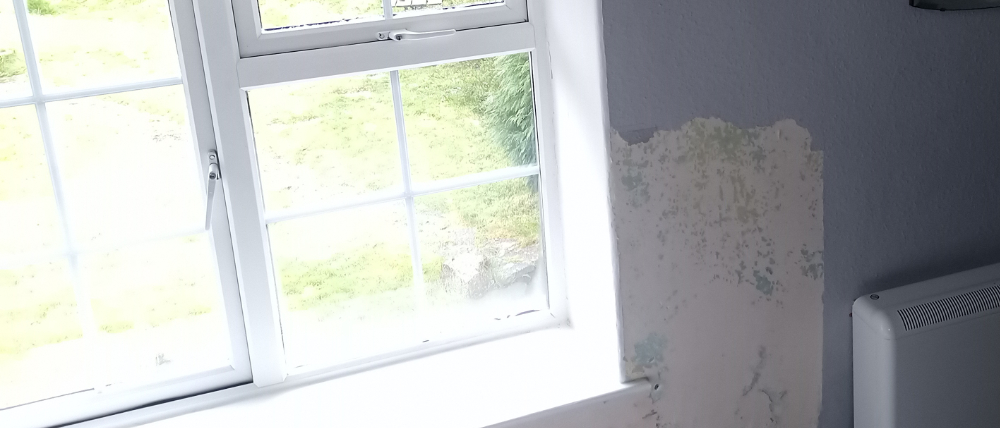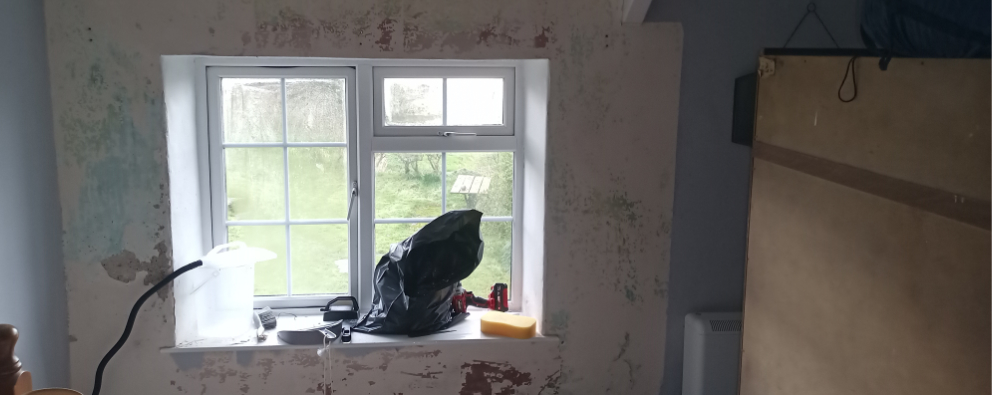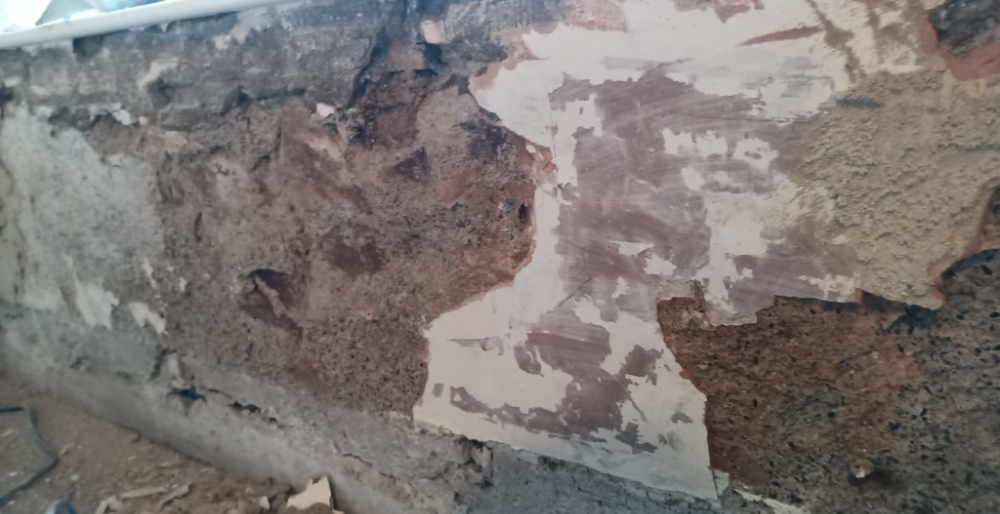Lime based thermal plaster part 1
Contents |
[edit] Brief intro
This is the first part of a short blog, experimenting with applying a known thermal lime plaster product internally. It is a 2 part article, the second of which can be found under Lime based thermal plaster part 2. It describes testing a product above and beyond the advice given by the manufacturer, which is not recommended. However, in this case, options were limited, and it was done with some knowledge of the risks involved.
[edit] Context
This project is in an old house with solid granite stone walls approximately 500 mm thick, with no kind of membrane as it was built in around 1600. The external faces of the building have been rendered, initially with lime but then probably with a cement mortar mix in the 70s–80s. The internal face of the front wall is exposed stonework with sand and cement pointing from the same period. The rear wall and the wall that is the focus of this project, internally had primarily the original lime plaster, with areas of patch gypsum plastering, particularly around the windows and elsewhere. It has had many layers of paint work over the years, most likely non-breathing paint, with the most recent finish being glue and then a patterned wall paper.
The cottage is rented as a holiday let. The room has always been cold and the rear wall always damp, and each year the wall paper needed to be stuck back down. The reasons are assumed to be partly because it is a first-floor wall and very exposed to driving rain and wind (costal location), and possibly because it has quite minimal overhangs at the eaves (historically, it was originally thatch), and there may be issues with the condition and size of gutters. The house is heated with night storage heaters, and although the loft has been insulated, the low eaves mean the pitch at the tops of the walls internally has minimal insulation, if any, as the other side is the ventilation space under the roof.
[edit] Limitations
In terms of the wall, the understanding is that the correct way and proper way to renovate it, would be to remove all the external and internal mixed lime and concrete render to expose the stonework, clear any cement mortar and start from scratch with lime-based products. Perhaps with a cost-effective hemp product; however, due to time and cost restrictions, as well as practicality ( scaffolding required etc ) this would most likely never be done. One option would be to remove the plaster internally, start again with lime, and then do the external face later, but again, time restricts this. Having looked at the variety of insulating plasters it was decided to stay away from organic-based materials, such as hemp shiv, cork, etc. because of the continued risk of damp in the wall and the potential to lead to rot with the organic materials. So all these elements considered, the options seemed to point towards a mineral-based solution, which in theory implies less risk associated with rotting, such as perlite, and a lime based product with a potentially greater threshold to cope with some damp issues, if there are any persisting, but improving thermally efficiency as well as breathability, at least internally.
Another challenge had been drying time, because, as a holiday let, the warmer periods are primary rental times, and the windows in between bookings can be short. Many lime-based products take time to dry and, as such, often can’t be quick in and out fix. Though this varies considerably with hydraulic and non-hydraulic lime, it also varies, it seems, with individual products. One lime-based product researched seemed to have a similar drying time to gypsum and offered a mineral based thermally insulating product, so I investigated further. Convinced of the drying time, and after speaking on the phone, the advice was familiar: to ideally remove all internal plasterwork, all render, and start from scratch. They offered three products: a thermal product, a hemp-based product, and a finished lime coat, all with similar drying times depending on thickness.
Knowing it wouldn’t be possible able to follow their recommendations entirely, but knowing the risks involved, it was decided to test and see if based on the above the plan of action would be okay, knowing risks and expectations. Knowing also the chances of having a dry surface to paint on in time were unlikely, meant earmarking the possibility of using pigments to speed things up, though this was also, clearly and understandably not recommended by the supplier. This is all being very sensible because manufacturers need to be 100% sure their product will function as advertised, and adding pigments or unspecified aspects can inevitably change performance. None the less progression was made with this essentially un recommended approach, a kin to to testing the product beyond its specification and seeing where the project managed to get to in the three weeks before the next guests were due to arrive. The thought of sticking down wall paper for yet another year and filling it with gypsum just didn’t make sense, so though not perfect, it seemed the better of the options on offer, even if not taking the best advice, and perhaps not the 'correct' way as such.
[edit] Related articles on Designing Buildings
- Binding agent.
- Cement mortar.
- Defects in brickwork.
- Defects in stonework.
- Dry hydrate lime mortar.
- Grout.
- Gypsum.
- Harl.
- Hemp lime construction: A guide to building with hemp lime composites.
- High alumina cement.
- High lime low alkali glass.
- Hot-mixed lime mortar.
- Hot-mixed mortars: the new lime revival.
- Hydraulic lime.
- Hydrated lime.
- Lime concrete.
- Lime mortar.
- Lime mortars vs. cement.
- Lime plaster.
- Lime putty mortar.
- Lime run-off.
- Mortar.
- Mortar analysis for specifiers.
- Non hydraulic lime.
- Pointing.
- Portland cement.
- Rendering.
- Soda-lime glass.
- Stucco.
- Types of mortar.
- The use of lime mortar in building conservation.
- Types of mortar.
Featured articles and news
Delivering for tenants; National Retrofit Hub
New report offers recommendations to strengthen energy efficiency standards to protect private renters.
Government consultations for the summer of 2025
A year of Labour, past and present consultations on the environment, the built environment, training and tax.
CMA competitiveness probe of major housing developers
100 million affordable housing contributions committed with further consultation published.
Homes England supports Greencore Homes
42 new build affordable sustainable homes in Oxfordshire.
Zero carbon social housing: unlocking brownfield potential
Seven ZEDpod strategies for brownfield housing success.
CIOB report; a blueprint for SDGs and the built environment
Pairing the Sustainable Development Goals with projects.
Types, tests, standards and fires relating to external cladding
Brief descriptions with an extensive list of fires for review.
Latest Build UK Building Safety Regime explainer published
Key elements in one short, now updated document.
UKGBC launch the UK Climate Resilience Roadmap
First guidance of its kind on direct climate impacts for the built environment and how it can adapt.
CLC Health, Safety and Wellbeing Strategy 2025
Launched by the Minister for Industry to look at fatalities on site, improving mental health and other issues.
One of the most impressive Victorian architects. Book review.
Common Assessment Standard now with building safety
New CAS update now includes mandatory building safety questions.
RTPI leader to become new CIOB Chief Executive Officer
Dr Victoria Hills MRTPI, FICE to take over after Caroline Gumble’s departure.
Social and affordable housing, a long term plan for delivery
The “Delivering a Decade of Renewal for Social and Affordable Housing” strategy sets out future path.
A change to adoptive architecture
Effects of global weather warming on architectural detailing, material choice and human interaction.
The proposed publicly owned and backed subsidiary of Homes England, to facilitate new homes.
How big is the problem and what can we do to mitigate the effects?
Overheating guidance and tools for building designers
A number of cool guides to help with the heat.
The UK's Modern Industrial Strategy: A 10 year plan
Previous consultation criticism, current key elements and general support with some persisting reservations.
Building Safety Regulator reforms
New roles, new staff and a new fast track service pave the way for a single construction regulator.




























